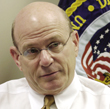Good news, bad news

Don't be fooled by the 7 percent increase in IT spending proposed in President Bush's fiscal 2006 budget request. Although the IT budget request of $65.1 billion boosts spending by more than 20 percent each at the departments of Homeland Security, Justice and Veterans Affairs, most agencies received only modest increases, and six had their IT budgets cut.
Don't be fooled by the 7 percent increase in IT spending proposed in President Bush's fiscal 2006 budget request. Although the IT budget request of $65.1 billion boosts spending by more than 20 percent each at the departments of Homeland Security, Justice and Veterans Affairs, most agencies received only modest increases, and six had their IT budgets cut.Additionally, among the 21 agencies slated to receive increases for 2006, five -- the departments of Education, State and Treasury, the Army Corps of Engineers and the Office of Personnel Management -- remain at or below their 2004 IT budgets. "We will have to manage as we always do, and maximize the money we have to make sure our spending makes sense," said Patrick Pizzella, the Labor Department's chief information officer. The Labor Department's IT budget was cut in 2005, and it faces a cut of $13 million to $409 million in 2006. In contrast, DHS is slated to receive $6 billion, a $1.2 billion increase that industry officials said compensated for two years of underfunding at the agency. "Officials recognized that some of the programs at Homeland Security, such as U.S. Visitor Immigrant and Status Indicator Technology System, were underfunded, considering the scope of the effort," said Jim Flyzik, a former DHS official and a partner with consulting firm Guerra, Kiviat, Flyzik and Associates of Oak Hill, Va. "Many of these programs were underfunded at the concept stage, but as you put more meat on the bones of the business cases, you can articulate the funding levels better."U.S. Visit is not the only program that would get a large increase. The Transportation Worker Identification Card, the Integrated Wireless Network and the Coast Guard's Nationwide Automatic Identification System would all get more than a $25 million boost in 2006."DHS clearly is a winner, and they might not get enough," said Robert Atkinson, vice president and director of technology and the new economy project for the Progressive Policy Institute in Washington. "I don't think the question for Homeland Security, as it is for all agencies, is really about overall funding, but it is much more about what the administration is investing in and how well they are doing it."Veterans Affairs was another budget winner with a $485 million increase to $2.1 billion for its IT budget. [IMGCAP(2)]"The increase is reflective of the administration's attitude toward IT as a toolset everyone needs to use, but they need to use it wisely to make government more effective," said CIO Robert McFarland.McFarland said more than $300 million of the increase is for the Veterans Health Information Systems and Technology Architecture.Although VA's increase, like many other agencies, is because of a planned big money need for an IT project next year, many of the department's expanded dollars are at the expense of other programs or personnel. The Defense Department, which has an IT budget that comprises nearly half of the entire federal technology expenditure, saw a 4.9 percent increase to $30.1 billion, its largest increase in four years. Linton Wells, the Defense Department's CIO, said he was encouraged by the 2006 budget process. "In the battle over digits versus widgets, widgets always win. This year, digits are winning," he said.Industry officials said it's not surprising that the departments of Defense and Homeland Security fared well in the budget request. Both departments perform missions that are top administration priorities, and both are in the middle of transformations. The IT budget requests reflect that."There are a lot of new capabilities and modes of operational services DOD is looking at dealing with, linking networks and getting soldiers a better picture of what is happening on the battle field," said Steven Kosiak, director of budget studies for Washington think tank the Center for Strategic and Budgetary Assessments. "All of the modernization or transformational efforts rest on, to some degree, putting more money into IT."Although most agencies are faced with tight budgets, they are successfully meeting the administration's IT goals. The Office of Management and Budget approved more business cases for the 2006 budget process than ever before, according to budget documents. Seventeen of 25 agencies had all their business cases approved, according to the budget. And just 342 IT business cases of 1,087 made the Management Watch List for lacking in one of three areas: assuring security; meeting cost, schedule and performance goals; or establishing performance measures. Last year, OMB said 621 of 1,130 IT projects made the watch list. The 342 programs are worth $15 billion, down $7 billion from last year. "We are starting to see the fruits of our labor," said Karen Evans, OMB administrator for IT and e-government. "We've been asking agencies to tell us how they are becoming more efficient and, to their credit, they have demonstrated the effectiveness of their IT programs and the metrics by which they measured it."Ray Bjorklund, senior vice president at Federal Sources Inc. of McLean, Va., said some of the decreased spending could be attributed to OMB's emphasis on better management."Many public IT companies have been reporting sluggish government spending to their investors," he said. "We believe this sluggishness could be due in part to OMB's exercising its oversight of IT programs. OMB may be slowing down the apportionment on major IT programs to ensure proper emphasis on program management due to some major missteps in government IT projects over the last few years." Jason Miller is a senior writer with Government Computer News. He can be reached at jmiller@postnewsweektech.com.



Jim Flyzik

The budget increase "is reflective of the administration's attitude toward IT as a tool set everyone needs to use, but they need to use it wisely to make government more effective." ? Robert McFarland, Veterans Affairs chief information officer
Henrik G. de Gyor
NEXT STORY: Megadata to help airport decision makers

